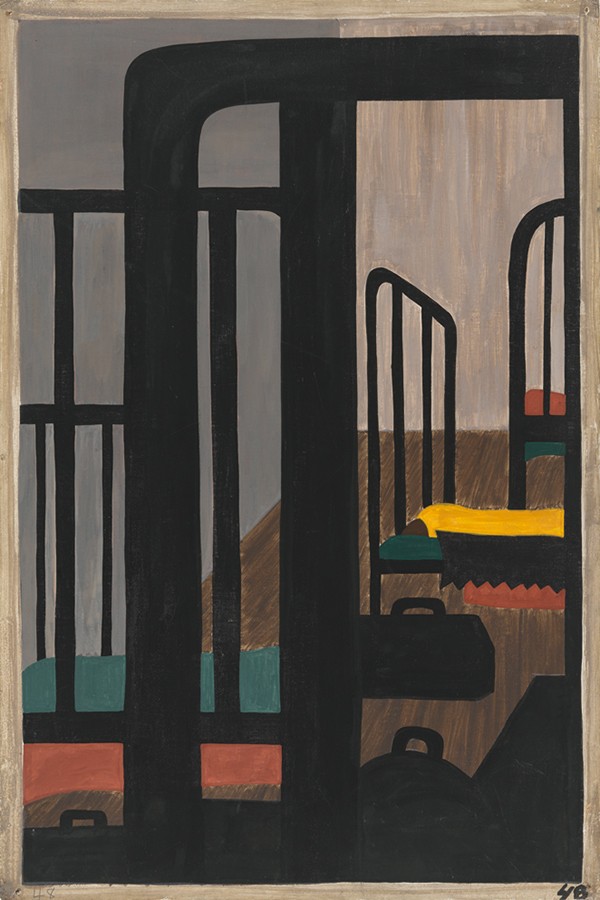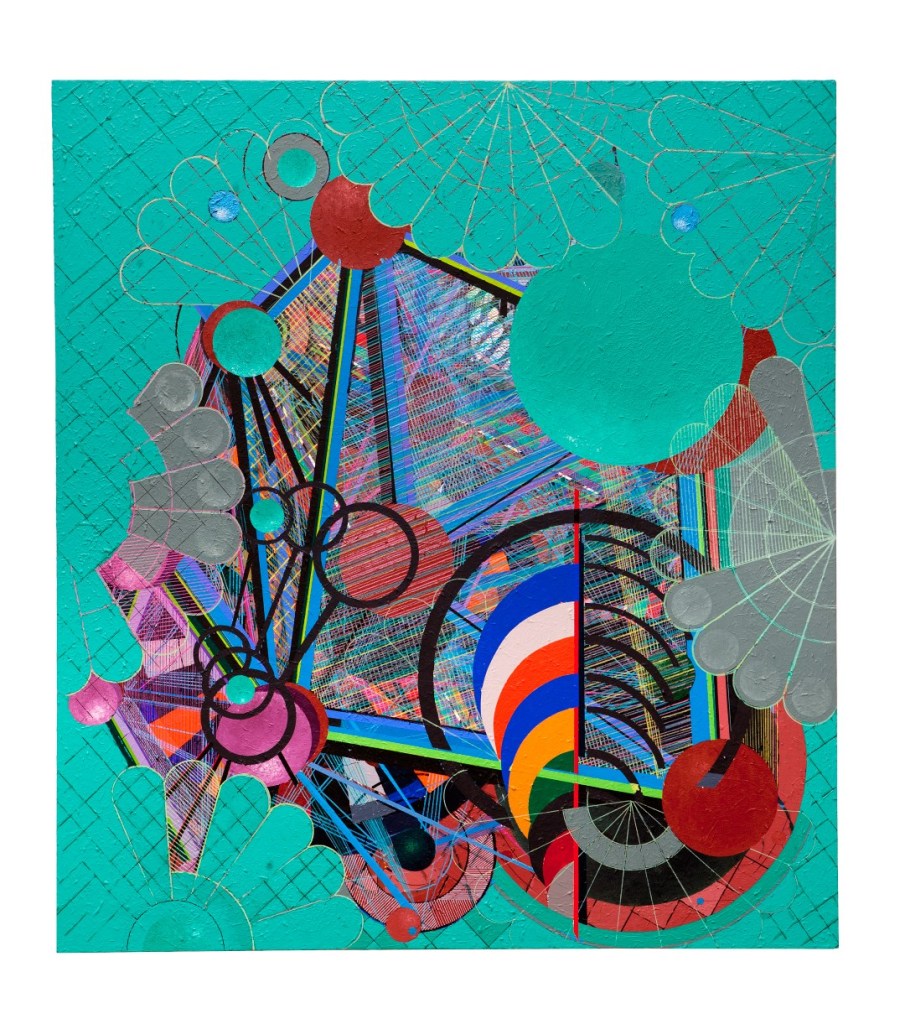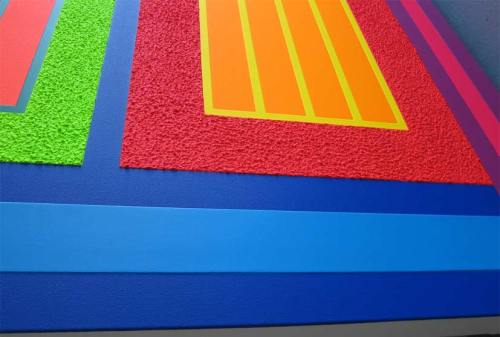Check out the work of Jacob Lawerence, particularly his Migration Series. This 60-panel epic was completed when he was only 23 years old.
https://lawrencemigration.phillipscollection.org/

Check out the work of Jacob Lawerence, particularly his Migration Series. This 60-panel epic was completed when he was only 23 years old.
https://lawrencemigration.phillipscollection.org/

Filed under Art, Art History, Artists, Painting, Uncategorized
Check out the work of Robert Reed, an alchemist of color and geometry. https://hyperallergic.com/491306/the-bauhaus-and-the-black-experience-the-magnificent-and-mysterious-robert-reed/

Filed under Art, Artists, Painting, Uncategorized
Here are some images from my recent show at Belhaven University. The show will be open until March 25th, 2020.
Filed under Art, Art Show, Drawing, Jacob Rowan Studios, Painting
“Red is the most joyful and dreadful thing in the physical universe; it is the fiercest note, it is the highest light, it is the place where the walls of this world of ours wear thinnest and something beyond burns through.
White is not a mere absence of color; it is a shining and affirmative thing, as fierce as red, as definite as black. God paints in many colors; but He never paints so gorgeously, I had almost said so gaudily, as when He paints in white.”
Does anybody have any good quotes about black as a color?
Filed under Art, Drawing, Jacob Rowan Studios, Painting, Quotes, Thursday Thoughts
The back and front of an element that will be cut out and included on the 4’x2′ cathedral painting I’m working on.
Filed under Art, Drawing, Jacob Rowan Studios, Painting, Saturday Studio Shot
Filed under Art, Drawing, Jacob Rowan Studios, Painting, Saturday Studio Shot
I’ve discovered I like applying paint by dabbing masked-off areas with a sponge. This creates a flat, slightly textured area of color with no brushstrokes. Once the paint dries I will flip the frosted mylar over and you will be able to see the color through the layers of drawing.
Filed under Drawing, Jacob Rowan Studios, Painting, Saturday Studio Shot

Mogamma II, Julie Mehretu, 2012, 180″x144″ (Be sure to click on image and scroll through the amazing complexity of the marks)
The above image is the second of Julie Mehretu’s Mogamma, A Painting in Four Parts. These four paintings were created around the time of the Arab Spring and consist of a complex web of gestural marks and vector lines overlaying technical wireframe drawings of Al-Mogamma (a government building in Tahir Square, Cairo). Mogamma is also the Arab word for “collective.”
Like most art, Mehretu’s paintings diminish when not seen in person. Much of the meaning of her work lies in experiencing these complex images at their massive scale and being unable to take in their entirety at once. They read one way from a distance, but as the viewer approaches they must select a portion of the image to examine more closely. Because it is physically impossible to see everything at once, the viewer must slow down and allow their eye to explore and discover the painting. Each person will see something slightly different as no two people will examine it in quite the same way. As Mark Godfrey said, “viewers have to abandon the desire to fully master what they see.”
In writing about Mehretu’s work Richard Shiff said, “The culture is complex, contradictory, and commodious; for better or worse, it tolerates extremes of opposition, assimilating diverse impulses, nevertheless avoiding collapse. To navigate a hyperculture of this sort requires a hyperimage, a perspective far more complex than a map of eighteenth-century trade routes…” I think what I find so fascinating about Mehretu’s work is the way in which her paintings function as hyperimages that juxtapose our perspective of chaotic experience with the suggestion of an underlying order. Her paintings are models and metaphors for a way of thinking about culture and reality.
“I think architecture reflects the machinations of politics, and that’s why I am interested in it as a metaphor for those institutions. I don’t think of architectural language as just a metaphor about space, but about spaces of power, about ideas of power.” – Julie Mehretu
Filed under Art, Art Meditation, Artists, Drawing, Jacob Rowan Studios, Painting, Quotes, Thursday Thoughts
“The deployment of the geometric dominates the landscape. Space is divided into discrete, isolated cells, explicitly determined as to extent and function. Cells are reached through complex networks of corridors and roadways that must be traveled at prescribed speeds and at prescribed times. The constant increase in the complexity and scale of these geometries continuously transforms the landscape…Along with the geometrization of the landscape, there occurs the geometrization of thought. Specific reality is displaced by the primacy of the model. And the model is in turn imposed on the landscape, further displacing reality in a process of ever more complete circularity. ”–The Deployment of the Geometric
Peter Halley’s visual langue primarily consists of the cell and the conduit, executed with endless variation. In an age when so much art is charged with political content and images from popular culture it may seem that Halley is merely painting pretty pictures. However, his paintings acquire layers of depth the more one reads his theories on geometry, abstraction, and society. He uses the formal language of modernism, and particularly that of abstract expressionists like Newman and Rothko, but with the cynicism and ironic tone of post-modernism. His work stands as a response to the hopeful geometric mysticism of artists like Mondrian and the abstract expressionists’ vision of the sublime.
“While the analysis of themes in the mass media is no doubt significant, an ideological exploration of geometry can be still more so for despite the profusion of media images in contemporary culture, geometric signs still remain the most ubiquitous and influential in our society. At almost every instant, we are confronted by countless geometrical signs, even in environments that are free of media signs….it is geometric signs in the form of art, architecture, and statistical analyses that the managerial class reserves to communicate with itself.” –The Crisis of Geometry
His work explores our fascination with the language of our enslavement. Or, to put it in his own words, “the very object of discomfort, geometry, is transformed into an object of adulation.” He questions whether geometric form is really the true essence of things or if it is merely the most expedient method of control. He asks the questions: “to what purpose is geometric form put to in our culture? Why is modern society so obsessed with geometric form that, for at least the last two centuries, we have striven to build and live in geometric environments of increasing complexity and exclusivity? Why has geometric art been so widely accepted in our century, and why has geometric imagery gained an unprecedented importance in our public iconography?”
“Space became geometrically differentiated and partitioned. Circulatory pathways, the omnipresent straight lines of the industrial landscape, were established to facilitate orderly movement” –The Crisis in Geometry
“The cell. Its ubiquity reflects the atrophy of the social and the rise of the interconnective. At the same time that the advent of piped-in “conveniences” has made it unnecessary to leave the cell, it has also made it impossible to leave the cell…In the planar universe, only color is capable of coding the linear with meaning: Colored lines on maps distinguish the character of highways. Wires are colored to mark their purpose. In hospitals, one can even follow colored bands on the floor through labyrinthine corridors to one’s destination.”–On Line
While the human figure never appears in his work, I find it interesting to consider how we increasingly conceive of ourselves in mechanistic terms. We use the language of “hooking up” or “recharging” to describe physical actions. We think of our brains as computers, even though they function in very different ways. Halley’s paintings visualize this language we have adopted to describe ourselves.
“The modern conception of man as a machine is more economic than biological in its accent. It refers to the human robot rather than the human animal, and suggests an efficient control of the costly movements of the body, a submission to some external purpose indifferent to the individual. . .Thus the social is finally becoming the site of “pure abstraction.” Each human being is no longer just a number, but is a collection of numbers, each of which ties him or her to a different matrix of information…With Mondrian, a decade later, any reference to specificity is gone and the world is described as an utopian grid of abstract flows and forces.”–Notes on Abstraction

Here’s a close-up of Cool Hunting to give you a better idea of the actual surface texture of Halley’s paintings.
You can find more images of his work and the complete essays quoted here on Peter Halley‘s website.